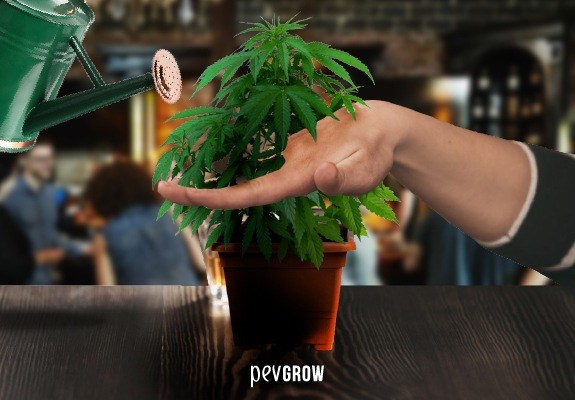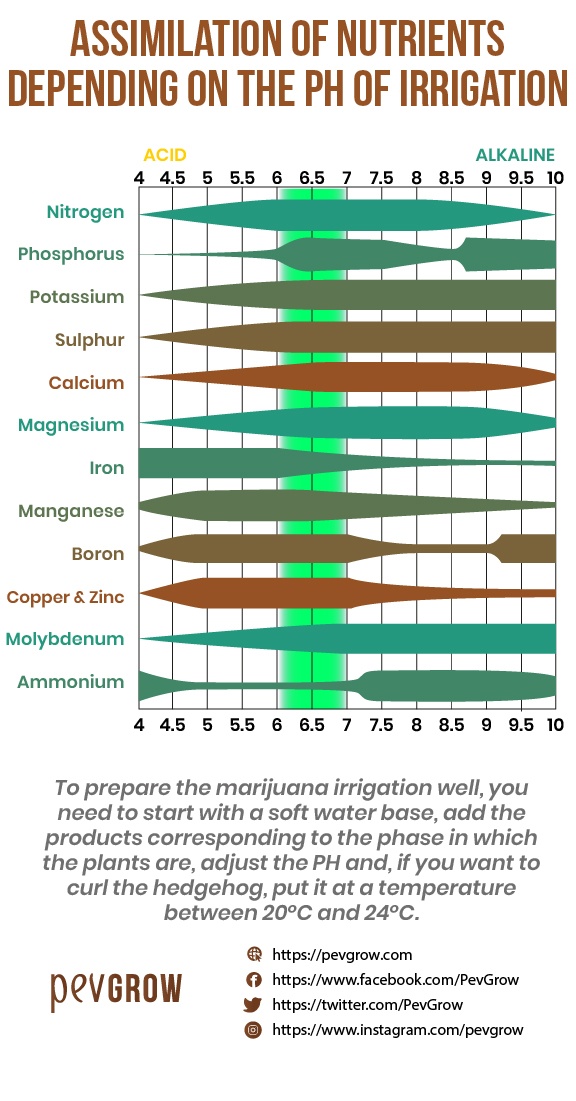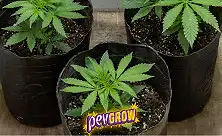

22-10-2021 09:00:26 - Updated: 22 October, 2021
Have you been growing cannabis for a short time and still don’t fully control how often and how much water your plants need? Do you want to install an automatic irrigation system and do not know how it works? Do you have to leave the house for a few days and are worried about the risks they need? Well, you have come to the most appropriate place, because in this article we will look at the best way to water marijuana plants in different situations.
⚠️ Irrigation of cannabis, wet-dry cycle, an important balance
Irrigation is essential for the maintenance of plants of any type, and although marijuana can be considered as a weed that grows everywhere, it is important to control certain aspects of irrigation for optimal development.
Irrigation is the way in which plants feed through the roots, because it allows the cationic exchange between the root system and the soil, which releases nutrients thanks to water, a chemical roll that we will not go into further due to how much be boring. . The important thing is that you know that the substrate cannot always be humid, because the roots also need oxygen and because if no air enters, fungi can be created, so the ideal is to respect the wet-dry cycle.
Between waterings it is essential that the substrate dries up, not completely because you don’t have to wait for the leaves to fall, but unless it allows oxygenation, and how do we know if it has aired or not between a watering and the other? There are several ways to find out, and it depends on the type of crop, but what you need to be very clear about is that roots need nutrients and oxygen for plants to develop perfectly.

🧐 How to water your cannabis plants in the best way?
The action of irrigation is simple, providing the water or nutrient solution to the plants, but is it still worth it? The answer is no. We must try to moisten the substrate little by little, making sure that the water reaches all points. Some gourmets water with a pressure sprayer to make this action as slow and smooth as possible, but it doesn’t take long, just go little by little, never right away.
There are also people who prefer watering by flooding, that is, instead of watering the top of the substrate, what they do is flood the tray or dishes where the plants are, and the soil absorbs moisture from the bottom up. Flood irrigation is very convenient, but it has the disadvantage of being dangerous for the possible formation of fungi.
🎬 How to water marijuana at home?
Indoor cannabis cultivation has more followers every day, consumers who start self-cultivation to be able to cover their offer without having to resort to the black market. Nobody is born knowing, and one of the first problems we encounter when we start this task is…How should we water? How much water? How long should I wait between irrigation and irrigation? Don’t worry, we’ve all had these doubts, but luckily you have this information at your fingertips.
First of all, we need to distinguish between crops land, coir, hydroponics and aeroponics, because each system has different needs. Most new growers start with pots and potting soil, as this is the most widely used and probably the simplest medium
Manual of marijuana grown with indoor soil
When the plants are small, we recommend watering with a watering manual , in this way we make sure that the soil is not too soaked and that there are no areas without humidity. Once the seed sprouts and sprouts from the ground, it can be watered around the stem of the plant, leaving the perimeter of the pot dry to ensure that the substrate continues to oxygenate. As the plant grows we will increase the amount of water, until the moment in which we will have to water the entire surface of the pot, and from that moment we will wait for it to dry before watering again.
Another way to know the amount of water in the substrate is with a Rapitest 3 in 1which, in addition to checking the humidity, measures the PH of the soil to know if it is in the correct values. Some growers stick a finger into the substrate to see if it’s dry or wet, but that’s not a good way to say it, as many times the top is dry but the rest is still wet.
👾 How to water a marijuana plant outdoors?
In outdoor crops, all processes are slower than in indoor crops, the season is longer and the days usually do not have as many hours of light as those we report indoors. That same pace needs to be adapted to risks and also take into account other issues such as environmental parameters.
We normally use larger pots outdoors than indoors, but plants also get bigger as a general rule. When the plant is small but the pot is large, try not to wet the substrate too much, better proceed slowly as we have seen before, watering around the main trunk and widening the irrigation diameter every time we water, until we get wet . Earth.
The water requirements of outdoor plants are different from those of indoor plants, and above all more variable. Inside we set parameters that remain stable, but outside the temperature, humidity, incidence of light and other factors change every day, so we have to adapt the irrigation according to the weather. Rain counts as irrigation, and the dew of the night is also absorbed by the leaves, so we can save some watering.
How to water marijuana plants planted in the ground?
If the plant is on mother earth, it does not have many problems with moisture accumulation, but it is still better to adapt the frequency and quantity of watering to the size of each specimen. A plant more than 2 meters tall planted directly in the ground may need more than 10 liters of water per day, but in reality some of it evaporates due to the heat or gets lost in the lower layers of the substrate.
That’s why the best way to water large outdoor plants placed in mother earth is with automatic watering, so you don’t have to prepare watering every day and you can’t worry. Automatic watering is also ideal for other situations, such as when you leave the house for a few days or for some reason you can’t keep an eye on the plants.
🎯 How to water the plants on vacation? Installing an automatic drip irrigation
To water the plants on vacation, it is best to install an automatic irrigation system, either individual or that allows the watering of several plants without having to be at home. The Wassertec battery-powered irrigation system is especially for outdoor crops because it does not need to be connected to the electrical network, since it works with batteries. It consists of a timer that is used to program irrigation, 10 meters of adjustable conduit and a pump that can be submerged in a flexible water tank such as the VDL brand. It is enough to prepare the nutrient solution in the tank, put the pump inside, program the irrigation frequency, and place the drippers in the pots of the plants that we want to water.
Another very economical solution is the Big Drippa Watering automatic irrigation system, made up of a small 10.5-litre tank, 5 meters of irrigation tube or conduit, and 6 drippers that can be placed in several small pots or together in one pot. great. The best thing is that it does not need electricity, since it works passively by gravity, and you only have to place the tank with the nutrient solution hanging in an area higher than the pots, and insert the drippers into the pots that you want to water in an automatic way. Along the same lines as this automatic irrigation kit, you also have the Wassertec irrigation bag available, which works in the same way as the Big Drippa Watering system but is still cheaper. Finally, I am going to present an automatic watering solution for individual pots, the Claber Idris kit, which in addition to being economical and very practical, is the easiest to install. It consists of a 2-liter capacity tank that is attached to an adjustable tripod, and at the bottom it has an automatic diffuser that ends in an interchangeable dropper to regulate the amount of irrigation water..
🔥 Systems to remove limescale from water and irrigate optimally
The general network water in many areas is too hard to water marijuana plants, as it contains too many salts and this can be a big problem in the short or medium term. In these cases, the best solution is to irrigate with reverse osmosis water, because they eliminate dissolved salts to leave soft water that is perfect for adding fertilizers and in this way that the plants can take what they need, without the risk of blockages due to salt accumulation. in the substrate.
The Mega Grow reverse osmosis filter from the Growmax Water brand is perfect for cannabis growers because it is capable of producing more than 1,000 liters of water per day, nothing to do with low-quality osmosis systems that take several days to process. This amount wastes a lot of water, and filters need to be changed often to keep them working effectively, so they cost more in the long run. Growmax Water is a professional system created by growers and for growers, and in addition to leaving perfect soft water for irrigation, it manages to eliminate Salts, Heavy Metals, Chloramines, Nitrates, Nitrites, Chlorine, Sediments, Earth, Oxides, Herbicides and Pesticides and other contaminants.
✅ Other important questions to consider before watering your cannabis plants, PH and EC
It is useless to have the best irrigation water with the best nutrients if you do not correct its PH. The PH is the potential of hydrogen contained in the water, it oscillates between 0 and 14, where 7 is the neutral value. The ideal pH of the irrigation water varies according to the cultivation system and the phase or time in which the plants are located, but normally it remains between the margins of 5 and 7.
EC or EC stands for electroconductivity, that is water water ability to conduct electricity, although for us the important thing is that this is how we measure the quantity of dissolved salts contained in the water, that is, the quantity of food when these salts are assimilated by plants.
To prepare the marijuana irrigation well, you need to start with a soft water base, add the products corresponding to the phase in which the plants are, adjust the PH and, if you want to curl the hedgehog, put it at a temperature between 20ºC and 24ºC. If you want to know more about the PH and EC of marijuana, I recommend that you read this article in which we detail everything much better.

🚀 How much water is needed in each irrigation?
This depends on many factors, such as the size of the pot, the temperature and relative humidity of the environment, the variety, the size of the plant, the phase in which it is, etc. but I will tell you that is just the right amount needed to wet all the substrate and drain a little through the bottom holes of the pot. Below you can see a list with the approximate quantities needed for each volume of :
- Pot to 0,5 liter : 50 ml. of water
- Pot to 1 liter : 100-150 ml. of water
- Pot to 3 liters : 300-400 ml. of water
- Pot to 7 liters : 700-800 ml. of water
- Pot to 11 liters : 1-1,2 liters of water
- Pot to 15 liters : 1,4-1,7 liters of water
- Pot to 25 liters : 2,3-2,7 liters of water
- Pot to 50 liters : 4,5-5,5 liters of water
What happens if I water the plants a little?
The problems of watering plants less than necessary are different. The first is that it slows down its development because it slows down the whole process. Another major problem occurs when areas of the pot run out of hydration, and the roots that are lodged in them can die, rendering them useless for the rest of the crop.
Another problem of lack of irrigation is due to the substrate, which when it dries too much no longer absorbs the water, and when you water most of it drains through the drainage holes. If this happens to you, there is a trick you can do, and that is to mix a couple of fairy drops (or any dish soap) with the irrigation water as a wetting agent. You can do the same when I spray any product too, as the soap allows the product you spray to stay in contact with the leaves longer, making it more effective.
➕ How do I know if I am overwatering a plant?
Watering too little is just as bad as watering too much, because either way the plant can end up dying. If you do the pot weight test freshly watered like I told you before, it is rare for you to have problems with over watering, but just in case I will tell you some signs that plants show in this situation.
When you water too much, it causes a lack of oxygenation of the root system, and this gradually creates nutrient deficiencies, as they are not assimilated well. If you see your plants starting to turn yellow their leaves due to sprouting, it could be due to an excess of water. Another sign is that you will see fallen leaves as when they lack water, but in this case, instead of looking wilted, they appear shiny, dark and with well-marked nerves, but by the weight of the moisture they contain, they outweigh. Another evident symptom is the slowing of the development rhythm, so much so that it seems that it lacks nutrients or has some blockage, but no, it is due to the lack of oxygen in the root zone.
📱 Conclusion
Today we have seen the importance of watering marijuana plants or any other well, how and when to do it correctly, how to prepare water for irrigation and how to water our plants when we are not at home. If you have any questions, you can ask us in the comments, and if you liked the article I hope you share it, thank you in advance.






